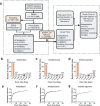An exploratory study evaluating the 20 medications most commonly associated with suicidal ideation and self-injurious behavior in the FAERS database
- PMID: 39885564
- PMCID: PMC11783939
- DOI: 10.1186/s40360-025-00858-7
An exploratory study evaluating the 20 medications most commonly associated with suicidal ideation and self-injurious behavior in the FAERS database
Abstract
Background: A number of pharmaceuticals, including antidepressants and antiepileptics, have a strong correlation with suicide risk. However, it is not entirely clear which of these medications are more strongly associated with suicide-related behaviors.
Objective: This study aims to elucidate the drugs responsible for drug-associated suicidal ideation or self-injurious, recognizing the severe consequences associated with such outcomes. However, it is not entirely clear which specific medications are associated with higher levels of suicide-related behavior. Real-world data from the FDA adverse event reporting system database were analyzed to identify medications correlated with suicidal ideation or self-injurious.
Methods: The reporting intensity of the High-Level Term "suicidal ideation or self-injurious behavior" and its Preferred Terms across distinct categories was assessed using the Reporting Odds Ratio (ROR) and Proportional Reporting Ratio (PRR).
Results: We identified the top 20 drugs with the highest reporting frequencies, spanning sedative-hypnotics, antidepressants, antipsychotics, antiepileptics, antihypertensives, antipyretic/analgesic drugs, and antihyperglycemic drugs. Ranking these medications according to ROR, the top five medications with ROR values related to suicidal ideation or self-injurious were alprazolam, zolpidem, amphetamine, quetiapine, and fluoxetine. Further analysis showed that suicide-related adverse events were more frequently reported in females. Antiepileptics had the highest frequency of reported adverse events in the 51-55 year age group, compared to 16-20 years for antidepressants and 46-50 years for sedative-hypnotics.
Conclusion: Our study provides valuable information for clinical drug selection by presenting a potential list of medication classes commonly associated with drug-associated suicidal ideation or self-injurious behavior. We observed a large number of adverse event reports of suicidal ideation with duloxetine and relatively few reports of suicide attempts. Acetaminophen and amlodipine had substantial adverse event reports of completed suicides, but may not be associated with drug-induced suicidal behavior. On the other hand, some drugs mentioned in this study, such as quetiapine, aripiprazole, and lamotrigine, are recommended to be used after assessing the risk level of suicide in patients.
Keywords: Disproportionality analysis; FAERS; Pharmacovigilance; Self-injurious; Suicidal ideation.
© 2025. The Author(s).
Conflict of interest statement
Declarations. Ethics approval and consent to participate: Ethical approval was not required for the study involvinghumans in accordance with the local legislation and institutionalrequirements. Written informed consent to participate in this study was not required from the participants or the participants’ legal guardians/next of kin in accordance with the national legislation and the institutional requirements. Consent for publication: Not applicable. Competing interests: The authors declare no competing interests.
Figures





Similar articles
-
New generation antidepressants for depression in children and adolescents: a network meta-analysis.Cochrane Database Syst Rev. 2021 May 24;5(5):CD013674. doi: 10.1002/14651858.CD013674.pub2. Cochrane Database Syst Rev. 2021. PMID: 34029378 Free PMC article.
-
Stratified analysis of the association between anti-obesity medications and digestive adverse events: a real-world study based on the FDA adverse event reporting system database.BMC Pharmacol Toxicol. 2024 Sep 12;25(1):64. doi: 10.1186/s40360-024-00789-9. BMC Pharmacol Toxicol. 2024. PMID: 39267168 Free PMC article.
-
Pharmacological intervention for irritability, aggression, and self-injury in autism spectrum disorder (ASD).Cochrane Database Syst Rev. 2023 Oct 9;10(10):CD011769. doi: 10.1002/14651858.CD011769.pub2. Cochrane Database Syst Rev. 2023. PMID: 37811711 Free PMC article.
-
Pharmacological treatments in panic disorder in adults: a network meta-analysis.Cochrane Database Syst Rev. 2023 Nov 28;11(11):CD012729. doi: 10.1002/14651858.CD012729.pub3. Cochrane Database Syst Rev. 2023. PMID: 38014714 Free PMC article.
-
Antidepressants for pain management in adults with chronic pain: a network meta-analysis.Health Technol Assess. 2024 Oct;28(62):1-155. doi: 10.3310/MKRT2948. Health Technol Assess. 2024. PMID: 39367772 Free PMC article.
References
MeSH terms
Grants and funding
LinkOut - more resources
Full Text Sources
Medical

